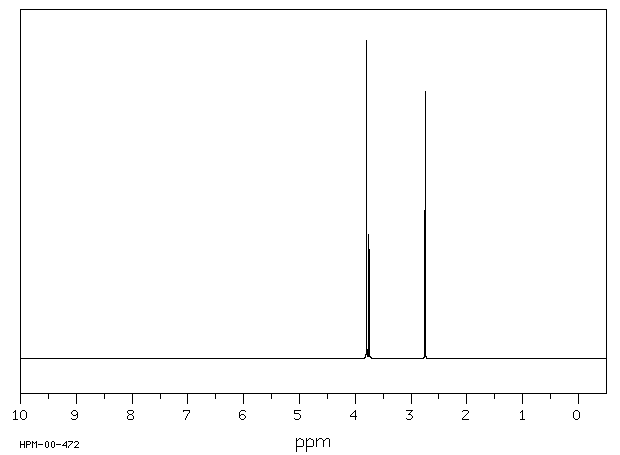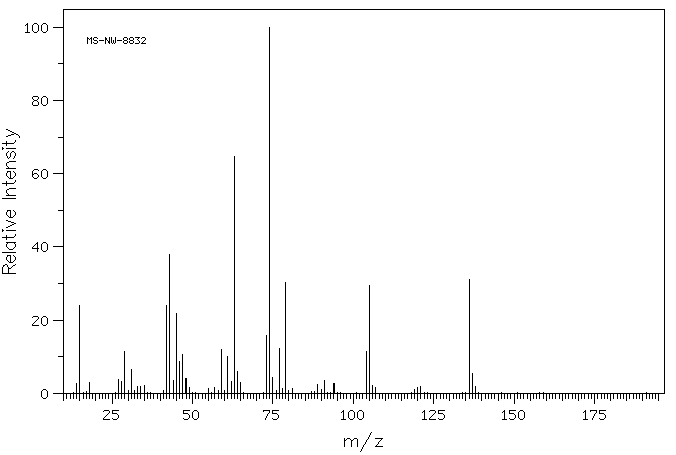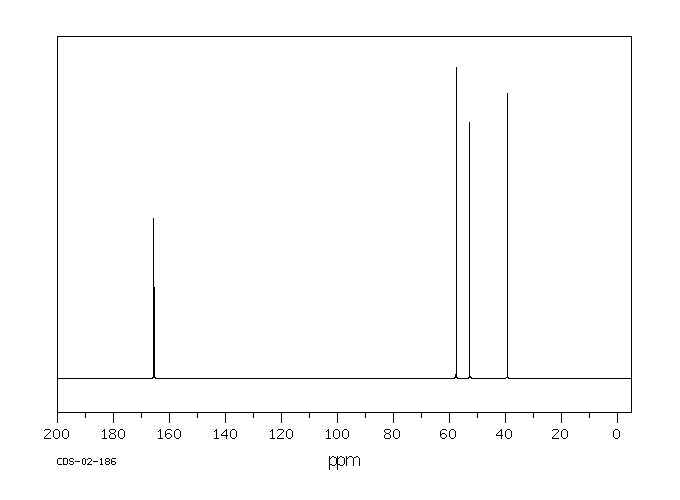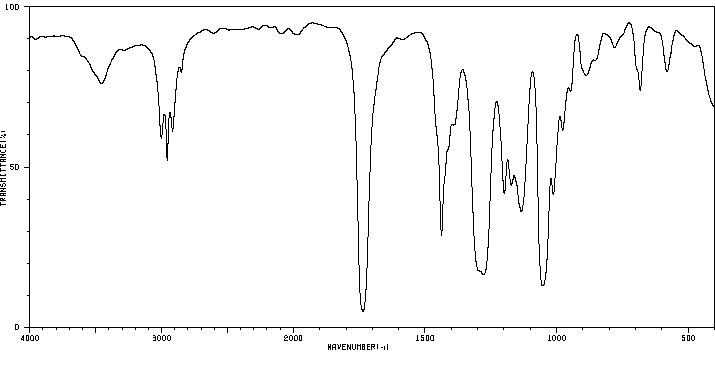(甲基亚磺酰)乙酸甲酯 | 52147-67-8
中文名称
(甲基亚磺酰)乙酸甲酯
中文别名
甲基亚磺酰基乙酸甲酯
英文名称
methyl methylsulfinyl acetate
英文别名
methyl(methylsulfinyl)acetate;methyl methylsulfinylacetate;Methyl-methylsulfinylacetat;Methyl (methylsulphinyl)acetate;methyl 2-methylsulfinylacetate
CAS
52147-67-8
化学式
C4H8O3S
mdl
MFCD00002092
分子量
136.172
InChiKey
DWNQOKWDJKLVEW-UHFFFAOYSA-N
BEILSTEIN
——
EINECS
——
-
物化性质
-
计算性质
-
ADMET
-
安全信息
-
SDS
-
制备方法与用途
-
上下游信息
-
文献信息
-
表征谱图
-
同类化合物
-
相关功能分类
-
相关结构分类
计算性质
-
辛醇/水分配系数(LogP):-0.6
-
重原子数:8
-
可旋转键数:3
-
环数:0.0
-
sp3杂化的碳原子比例:0.75
-
拓扑面积:62.6
-
氢给体数:0
-
氢受体数:4
安全信息
-
海关编码:2930909090
SDS
| Name: | Methyl(Methylsulfinyl)Acetate 96% Material Safety Data Sheet |
| Synonym: | None |
| CAS: | 52147-67-8 |
Synonym:None
Section 2 - COMPOSITION, INFORMATION ON INGREDIENTS
| CAS# | Chemical Name | content | EINECS# |
| 52147-67-8 | Methyl (Methylsulfinyl)acetate | 96% | 257-691-9 |
Risk Phrases: 36/37/38
Section 3 - HAZARDS IDENTIFICATION
EMERGENCY OVERVIEW
Irritating to eyes, respiratory system and skin.Stench.The toxicological properties of this material have not been fully investigated.
Potential Health Effects
Eye:
Causes eye irritation.
Skin:
Causes skin irritation.
Ingestion:
Causes gastrointestinal irritation with nausea, vomiting and diarrhea. The toxicological properties of this substance have not been fully investigated.
Inhalation:
Causes respiratory tract irritation. The toxicological properties of this substance have not been fully investigated.
Chronic:
No information found.
Section 4 - FIRST AID MEASURES
Eyes: Flush eyes with plenty of water for at least 15 minutes, occasionally lifting the upper and lower eyelids. Get medical aid.
Skin:
Get medical aid. Flush skin with plenty of water for at least 15 minutes while removing contaminated clothing and shoes. Wash clothing before reuse.
Ingestion:
Never give anything by mouth to an unconscious person. Get medical aid. Do NOT induce vomiting. If conscious and alert, rinse mouth and drink 2-4 cupfuls of milk or water. Wash mouth out with water.
Inhalation:
Remove from exposure and move to fresh air immediately. If not breathing, give artificial respiration. If breathing is difficult, give oxygen. Get medical aid.
Notes to Physician:
Treat symptomatically and supportively.
Section 5 - FIRE FIGHTING MEASURES
General Information:
As in any fire, wear a self-contained breathing apparatus in pressure-demand, MSHA/NIOSH (approved or equivalent), and full protective gear. During a fire, irritating and highly toxic gases may be generated by thermal decomposition or combustion. Use water spray to keep fire-exposed containers cool. Vapors may be heavier than air. They can spread along the ground and collect in low or confined areas. Containers may explode when heated.
Extinguishing Media:
Use agent most appropriate to extinguish fire. Cool containers with flooding quantities of water until well after fire is out. Use water spray, dry chemical, carbon dioxide, or appropriate foam.
Section 6 - ACCIDENTAL RELEASE MEASURES
General Information: Use proper personal protective equipment as indicated in Section 8.
Spills/Leaks:
Absorb spill with inert material (e.g. vermiculite, sand or earth), then place in suitable container. Avoid runoff into storm sewers and ditches which lead to waterways. Clean up spills immediately, observing precautions in the Protective Equipment section. Remove all sources of ignition. Provide ventilation.
Section 7 - HANDLING and STORAGE
Handling:
Wash thoroughly after handling. Use with adequate ventilation. Avoid breathing dust, vapor, mist, or gas. Avoid contact with eyes, skin, and clothing. Keep container tightly closed. Avoid ingestion and inhalation. Use only in a chemical fume hood. Wash clothing before reuse.
Storage:
Store in a tightly closed container. Store in a cool, dry, well-ventilated area away from incompatible substances.
Section 8 - EXPOSURE CONTROLS, PERSONAL PROTECTION
Engineering Controls:
Facilities storing or utilizing this material should be equipped with an eyewash facility and a safety shower. Use adequate ventilation to keep airborne concentrations low.
Exposure Limits CAS# 52147-67-8: Personal Protective Equipment Eyes: Wear appropriate protective eyeglasses or chemical safety goggles as described by OSHA's eye and face protection regulations in 29 CFR 1910.133 or European Standard EN166.
Skin:
Wear appropriate protective gloves to prevent skin exposure.
Clothing:
Wear appropriate protective clothing to prevent skin exposure.
Respirators:
A respiratory protection program that meets OSHA's 29 CFR 1910.134 and ANSI Z88.2 requirements or European Standard EN 149 must be followed whenever workplace conditions warrant respirator use.
Section 9 - PHYSICAL AND CHEMICAL PROPERTIES
Physical State: Liquid
Color: colorless
Odor: stench
pH: Not available.
Vapor Pressure: Not available.
Viscosity: Not available.
Boiling Point: 103 - 104 deg C @ 2.50mm Hg
Freezing/Melting Point: Not available.
Autoignition Temperature: Not available.
Flash Point: > 110 deg C (> 230.00 deg F)
Explosion Limits, lower: Not available.
Explosion Limits, upper: Not available.
Decomposition Temperature:
Solubility in water:
Specific Gravity/Density: 1.2540g/cm3
Molecular Formula: C4H8O3S
Molecular Weight: 136.17
Section 10 - STABILITY AND REACTIVITY
Chemical Stability:
Stable at room temperature in closed containers under normal storage and handling conditions.
Conditions to Avoid:
Incompatible materials, ignition sources, excess heat.
Incompatibilities with Other Materials:
Strong oxidizing agents, strong bases.
Hazardous Decomposition Products:
Carbon monoxide, oxides of sulfur, irritating and toxic fumes and gases, carbon dioxide.
Hazardous Polymerization: Has not been reported
Section 11 - TOXICOLOGICAL INFORMATION
RTECS#:
CAS# 52147-67-8 unlisted.
LD50/LC50:
Not available.
Carcinogenicity:
Methyl (Methylsulfinyl)acetate - Not listed by ACGIH, IARC, or NTP.
Section 12 - ECOLOGICAL INFORMATION
Section 13 - DISPOSAL CONSIDERATIONS
Dispose of in a manner consistent with federal, state, and local regulations.
Section 14 - TRANSPORT INFORMATION
IATA
Not regulated as a hazardous material.
IMO
Not regulated as a hazardous material.
RID/ADR
Not regulated as a hazardous material.
Section 15 - REGULATORY INFORMATION
European/International Regulations
European Labeling in Accordance with EC Directives
Hazard Symbols: XI
Risk Phrases:
R 36/37/38 Irritating to eyes, respiratory system
and skin.
Safety Phrases:
S 26 In case of contact with eyes, rinse immediately
with plenty of water and seek medical advice.
S 28A After contact with skin, wash immediately with
plenty of water.
S 37 Wear suitable gloves.
S 37/39 Wear suitable gloves and eye/face
protection.
S 45 In case of accident or if you feel unwell, seek
medical advice immediately (show the label where
possible).
WGK (Water Danger/Protection)
CAS# 52147-67-8: No information available.
Canada
None of the chemicals in this product are listed on the DSL/NDSL list.
CAS# 52147-67-8 is not listed on Canada's Ingredient Disclosure List.
US FEDERAL
TSCA
CAS# 52147-67-8 is not listed on the TSCA inventory.
It is for research and development use only.
SECTION 16 - ADDITIONAL INFORMATION
N/A
上下游信息
-
上游原料
中文名称 英文名称 CAS号 化学式 分子量 甲基硫代乙酸甲酯 methyl 2-(methylthio)acetate 16630-66-3 C4H8O2S 120.172
反应信息
-
作为反应物:描述:(甲基亚磺酰)乙酸甲酯 、 1,2,3,6,7,8-六氢芘 在 四氯化锡 、 三氟乙酸酐 作用下, 以 二氯甲烷 为溶剂, 反应 0.5h, 以74%的产率得到methyl (1,2,3,6,7,8-hexahydropyren-4-yl)(methylthio)acetate参考文献:名称:A convenient synthesis of cyclopenta[c,d]pyrene摘要:DOI:10.1021/jo00383a039
-
作为产物:参考文献:名称:杂多钨锡酸酯作为Knoevenagel缩合,硫化物的选择性氧化和醛的氧化胺化的均相和非均相催化剂摘要:杂多钨锡酸锡K 11 H [P 2 W 18 O 68(HOSn IV OH)3 ]·20H 2 O(1)被用作Knoevenagel缩合反应的均相和非均相催化剂。通过(1)的静电接枝制备了新的Fe 3 O 4 @SiO 2 @CH 2(CH 2)2 NH 3 + [P 2 W 18 O 68(HOSn IV OH)3 ] 11-纳米催化剂。)在胺改性的二氧化硅包覆的磁性纳米粒子上。使用红外光谱(IR),扫描电子显微镜(SEM),透射电子显微镜(TEM),X射线粉末衍射(XRD),能量色散X射线分析(EDX)和交替梯度对新型可磁回收纳米催化剂进行了表征磁力计(AGFM)。结果表明,颗粒的形状大多为球形,平均尺寸约为<30 nm。研究了在水性介质中硫化物选择性氧化为亚砜和醛的氧化胺化反应中催化剂的催化活性。催化剂被重复使用至少五次而没有明显降低催化活性,并且催化剂的结构在循环后保持不变。DOI:10.1039/c7ra06112a
文献信息
-
Self-Catalyzed Oxidation of Sulfides with Hydrogen Peroxide: A Green and Practical Process for the Synthesis of Sulfoxides作者:Feng Shi、Man Kin Tse、Hanns Martin Kaiser、Matthias BellerDOI:10.1002/adsc.200700206日期:2007.11.5A self-catalyzed selective oxidation of sulfides to sulfoxides has been developed. The scope of the protocol is demonstrated in the selective oxidation of 17 different substrates. High yields and chemoselectivity (in general >90 %) are achieved in most cases.
-
Wladislaw, B.; Marzorati, L.; Gruber, J., Phosphorus, Sulfur and Silicon and the Related Elements, 1990, vol. 47, # 1+2, p. 21 - 26作者:Wladislaw, B.、Marzorati, L.、Gruber, J.DOI:——日期:——
-
Reactions of N-sulfinylamides with sulfoxides bearing electronegative substituents作者:Toru Minami、Yutaka Tsumori、Kikuo Yoshida、Toshio AgawaDOI:10.1021/jo00937a024日期:1974.11
-
Laccase-TEMPO as an efficient catalyst system for metal- and halogen-free aerobic oxidation of thioethers to sulfoxides in aqueous media at ambient conditions作者:Amin Rostami、Behnaz Mohammadi、Zahra Shokri、Shaghayegh SaadatiDOI:10.1016/j.catcom.2018.03.032日期:2018.6We present for the first time an eco-friendly procedure for the aerobic oxidation of thioethers to sulfoxides using laccase-TEMPO catalyst system. This catalyst system allows for simpler (easy work-up) and greener methodologies (room temperature, phosphate buffer) while keeping high reaction yields and selectivity. This work is superior to others due to free from any transition metal and halide co-catalysts.
-
New synthetic reactions. Allylic alkylation作者:Barry M. Trost、Terry J. FullertonDOI:10.1021/ja00782a080日期:1973.1
表征谱图
-
氢谱1HNMR
-
质谱MS
-
碳谱13CNMR
-
红外IR
-
拉曼Raman
-
峰位数据
-
峰位匹配
-
表征信息
同类化合物
(甲基3-(二甲基氨基)-2-苯基-2H-azirene-2-羧酸乙酯)
(±)-盐酸氯吡格雷
(±)-丙酰肉碱氯化物
(d(CH2)51,Tyr(Me)2,Arg8)-血管加压素
(S)-(+)-α-氨基-4-羧基-2-甲基苯乙酸
(S)-阿拉考特盐酸盐
(S)-赖诺普利-d5钠
(S)-2-氨基-5-氧代己酸,氢溴酸盐
(S)-2-[[[(1R,2R)-2-[[[3,5-双(叔丁基)-2-羟基苯基]亚甲基]氨基]环己基]硫脲基]-N-苄基-N,3,3-三甲基丁酰胺
(S)-2-[3-[(1R,2R)-2-(二丙基氨基)环己基]硫脲基]-N-异丙基-3,3-二甲基丁酰胺
(S)-1-(4-氨基氧基乙酰胺基苄基)乙二胺四乙酸
(S)-1-[N-[3-苯基-1-[(苯基甲氧基)羰基]丙基]-L-丙氨酰基]-L-脯氨酸
(R)-乙基N-甲酰基-N-(1-苯乙基)甘氨酸
(R)-丙酰肉碱-d3氯化物
(R)-4-N-Cbz-哌嗪-2-甲酸甲酯
(R)-3-氨基-2-苄基丙酸盐酸盐
(R)-1-(3-溴-2-甲基-1-氧丙基)-L-脯氨酸
(N-[(苄氧基)羰基]丙氨酰-N〜5〜-(diaminomethylidene)鸟氨酸)
(6-氯-2-吲哚基甲基)乙酰氨基丙二酸二乙酯
(4R)-N-亚硝基噻唑烷-4-羧酸
(3R)-1-噻-4-氮杂螺[4.4]壬烷-3-羧酸
(3-硝基-1H-1,2,4-三唑-1-基)乙酸乙酯
(2S,4R)-Boc-4-环己基-吡咯烷-2-羧酸
(2S,3S,5S)-2-氨基-3-羟基-1,6-二苯己烷-5-N-氨基甲酰基-L-缬氨酸
(2S,3S)-3-((S)-1-((1-(4-氟苯基)-1H-1,2,3-三唑-4-基)-甲基氨基)-1-氧-3-(噻唑-4-基)丙-2-基氨基甲酰基)-环氧乙烷-2-羧酸
(2S)-2,6-二氨基-N-[4-(5-氟-1,3-苯并噻唑-2-基)-2-甲基苯基]己酰胺二盐酸盐
(2S)-2-氨基-N,3,3-三甲基-N-(苯甲基)丁酰胺
(2S)-2-氨基-3-甲基-N-2-吡啶基丁酰胺
(2S)-2-氨基-3,3-二甲基-N-(苯基甲基)丁酰胺,
(2S)-2-氨基-3,3-二甲基-N-2-吡啶基丁酰胺
(2S,4R)-1-((S)-2-氨基-3,3-二甲基丁酰基)-4-羟基-N-(4-(4-甲基噻唑-5-基)苄基)吡咯烷-2-甲酰胺盐酸盐
(2R,3'S)苯那普利叔丁基酯d5
(2R)-2-氨基-3,3-二甲基-N-(苯甲基)丁酰胺
(2-氯丙烯基)草酰氯
(1S,3S,5S)-2-Boc-2-氮杂双环[3.1.0]己烷-3-羧酸
(1R,5R,6R)-5-(1-乙基丙氧基)-7-氧杂双环[4.1.0]庚-3-烯-3-羧酸乙基酯
(1R,4R,5S,6R)-4-氨基-2-氧杂双环[3.1.0]己烷-4,6-二羧酸
齐特巴坦
齐德巴坦钠盐
齐墩果-12-烯-28-酸,2,3-二羟基-,苯基甲基酯,(2a,3a)-
齐墩果-12-烯-28-酸,2,3-二羟基-,羧基甲基酯,(2a,3b)-(9CI)
黄酮-8-乙酸二甲氨基乙基酯
黄荧菌素
黄体生成激素释放激素(1-6)
黄体生成激素释放激素 (1-5) 酰肼
黄体瑞林
麦醇溶蛋白
麦角硫因
麦芽聚糖六乙酸酯
麦根酸










